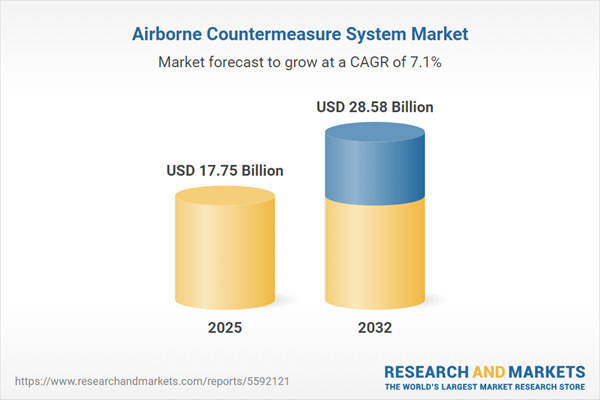Speak directly to the analyst to clarify any post sales queries you may have.
The airborne countermeasure system market is undergoing swift transformation as global defense organizations adapt to rapidly changing threat environments. Senior leaders must closely monitor technological innovation, supply chain shifts, and evolving strategies within this highly dynamic sector.
Market Snapshot: Airborne Countermeasure System Market Growth and Outlook
The Airborne Countermeasure System Market experienced notable expansion, growing from USD 16.56 billion in 2024 to USD 17.75 billion in 2025. It is projected to maintain a compound annual growth rate (CAGR) of 7.06%, reaching USD 28.58 billion by 2032. Increased defense investments, escalating threat sophistication, and defense modernization programs are fueling this growth trajectory across regions.
Comprehensive Scope & Market Segmentation
This report provides senior decision-makers with a nuanced view of the global airborne countermeasure system market, breaking down the landscape across key technologies, platforms, product categories, deployment modes, end uses, and pivotal regions.
- Technology: Chaff, directed infrared countermeasures (including laser-based and LED-based systems), electronic countermeasures (active jammers, passive jammers), and flares.
- Platform: Fighter aircraft (air superiority, multi-role, stealth), helicopters (attack, cargo, utility), transport aircraft (strategic, tactical), and unmanned aerial vehicles (HALE, MALE, tactical).
- Product Type: Hard kill (directed energy weapons—laser-based, interceptor missiles) and soft kill (chaff, electronic countermeasures—active and passive jammers, flares).
- Deployment Mode: Internal installations and pod-mounted configurations.
- End Use: Civilian commercial aviation and military (air force, army aviation, navy).
- Geography: Americas (North America, Latin America), Europe, Middle East & Africa, and Asia-Pacific, with further granularity for national markets such as the United States, United Kingdom, Germany, France, Russia, UAE, China, India, Japan, and others.
- Leading Companies: BAE Systems plc, Raytheon Technologies Corporation, Saab AB, Elbit Systems Ltd., Leonardo S.p.A., Thales Group, and L3Harris Technologies, Inc.
Key Takeaways for Senior Decision-Makers
- Intensifying global threat environments are driving increased adoption of both advanced hard kill and soft kill countermeasure solutions, tailored for different platform requirements and operational scenarios.
- The integration of cognitive electronic warfare and AI-powered threat prediction is shifting performance benchmarks, supporting rapid decision-making in multi-domain operations.
- Vendor strategies are rapidly evolving, with defense primes and technology disruptors forming agile partnerships for R&D, accelerating the time-to-market for next-generation products.
- Platform diversity—including fighter jets, transport aircraft, rotary-wing platforms, and UAVs—requires a flexible suite of countermeasure options that can be modularly installed or retrofitted.
- Regional strategies differ markedly; for instance, the Americas and Europe focus on advanced electronic warfare suites and international cooperation, while Asia-Pacific is emphasizing indigenous capability acceleration and workforce development.
Tariff Impact: Navigating Shifting Procurement and Cost Structures
Recent tariff adjustments in the United States have created significant cost and sourcing implications. Suppliers are adjusting manufacturing footprints, exploring dual sourcing, and reclassifying critical components to mitigate duty exposure. Procurement leaders are embedding tariff resilience through strategic vendor partnerships, contract clauses, and collaborative agreements, ensuring sustained readiness in high-stakes defense programs. These shifts are driving collective purchasing power and encouraging co-development across allied nations, shaping the trajectory of future supply chains.
Methodology & Data Sources
The report integrates primary interviews with defense procurement leaders, platform integrators, and electronic warfare specialists, complemented by secondary research from defense publications and government documents. Quantitative analysis is based on a bottom-up approach, utilizing platform inventories and defense expenditure trends. Scenario planning and sensitivity analysis further strengthen the reliability of the findings.
Why This Report Matters for Decision-Makers
- Empowers executives with strategic insights into evolving market dynamics, allowing for more informed investment and partnership decisions.
- Provides actionable intelligence on key technology adoption pathways, procurement strategies, and supply chain adaptation essential for maintaining readiness and regulatory compliance.
Conclusion: Strategic Perspectives and Future Directions
The airborne countermeasure system market stands at the intersection of technology evolution, regulatory shifts, and diverse operational demands. Forward-thinking organizations will benefit from modular, scalable solutions and a robust approach to partnership and compliance. This report delivers the clarity and depth senior leaders require to navigate a complex, opportunity-rich environment.
Additional Product Information:
- Purchase of this report includes 1 year online access with quarterly updates.
- This report can be updated on request. Please contact our Customer Experience team using the Ask a Question widget on our website.
Table of Contents
3. Executive Summary
4. Market Overview
7. Cumulative Impact of Artificial Intelligence 2025
List of Figures
Samples

LOADING...
Companies Mentioned
The key companies profiled in this Airborne Countermeasure System market report include:- BAE Systems plc
- Raytheon Technologies Corporation
- Saab AB
- Elbit Systems Ltd.
- Leonardo S.p.A.
- Thales Group
- L3Harris Technologies, Inc.
Table Information
| Report Attribute | Details |
|---|---|
| No. of Pages | 187 |
| Published | October 2025 |
| Forecast Period | 2025 - 2032 |
| Estimated Market Value ( USD | $ 17.75 Billion |
| Forecasted Market Value ( USD | $ 28.58 Billion |
| Compound Annual Growth Rate | 7.0% |
| Regions Covered | Global |
| No. of Companies Mentioned | 8 |









